Studying effectively isn’t just about spending more hours with your books — it’s about using smarter techniques. One such method gaining popularity among students and educators is the Blurting Method. In this guide, you’ll learn what blurting is, how it works, and how you can apply it to improve your memory, understanding, and exam performance.
Introduction to the Blurting Method
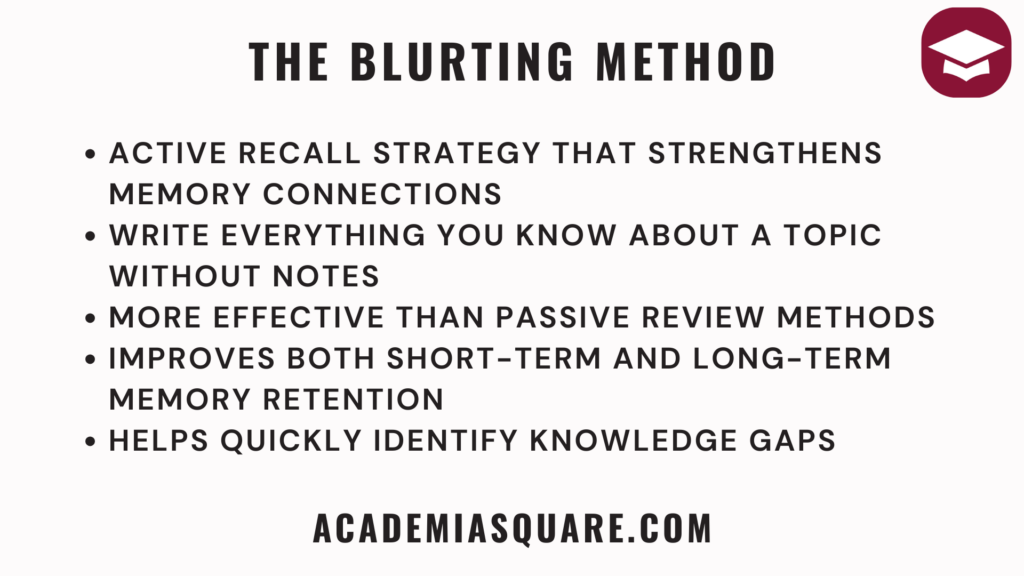
The Blurting Method is a unique study technique that has gained significant attention due to its simplicity and effectiveness in improving memory retention. It is an active recall strategy that involves writing down everything you know about a subject without looking at your notes. The idea is to retrieve information from memory, which strengthens neural connections, and then review what you missed or got wrong. This method is particularly useful for students preparing for exams or individuals who need to retain a large amount of information.
While many students rely on passive review methods, such as rereading textbooks or notes, research has shown that active recall methods like the Blurting Method are far more effective. According to cognitive psychology, actively recalling information forces the brain to strengthen its pathways and increase long-term retention. This is why the Blurting Method stands out as an efficient way to study, offering more than just surface-level memorization.
Why Blurting Works
The effectiveness of the Blurting Method lies in its ability to engage the brain in active learning. When you blurting—writing everything you can recall about a topic—you are essentially challenging your memory and testing your understanding. This process activates the retrieval practice, which is a scientifically-backed technique known to boost memory consolidation. The act of “blurring” also helps identify knowledge gaps, so you can focus on areas that need further attention.
Key Benefits of the Blurting Method
- Improved retention: Actively recalling information strengthens your memory.
- Engagement with the material: The process forces you to interact deeply with the content.
- Identifying gaps: You’ll quickly spot areas where you need to focus more.
In addition to these benefits, research shows that active recall not only helps with short-term retention but also aids in long-term memory storage. Studies have found that students who practice active recall techniques retain information for longer periods compared to those who engage in passive review methods.
To sum up, the Blurting Method is a simple yet powerful study strategy. By actively engaging with the material and forcing yourself to recall information from memory, you’ll significantly improve your ability to retain and understand what you’re learning. In the following chapters, we will break down how you can use this method to enhance your study sessions and see real improvements in your academic performance.
What Is the Blurting Method?
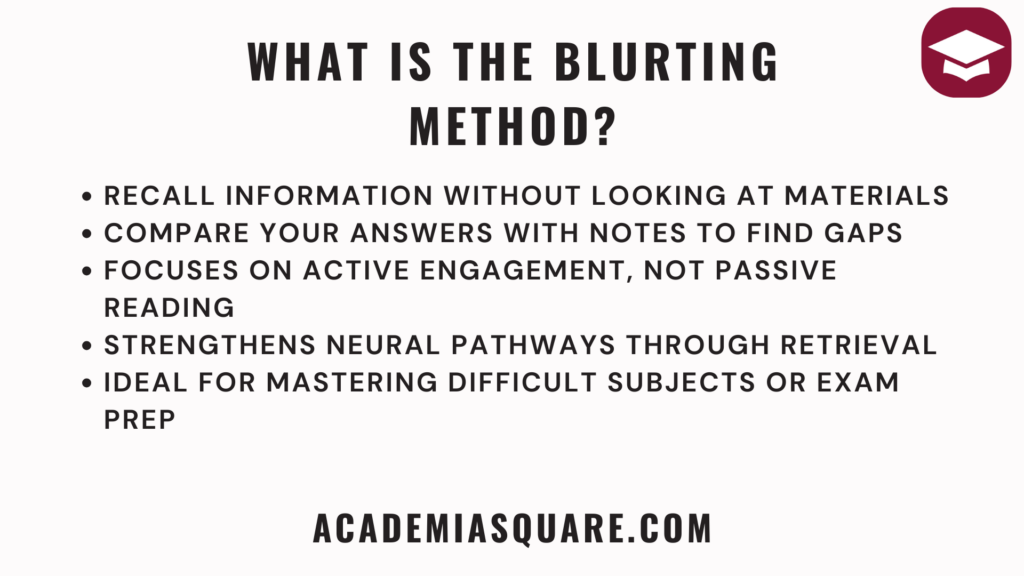
The Blurting Method is a dynamic, hands-on approach to learning and memorization. It involves recalling everything you know about a subject without referencing any materials. Once you’ve written down everything, you can compare it to your notes or textbooks to identify gaps in your knowledge. By forcing your brain to recall information without external cues, the Blurting Method helps you retain knowledge more effectively and identify weak areas that need improvement.
Understanding the Core Concept of Blurting
At its core, the Blurting Method revolves around active recall, which is one of the most effective ways to reinforce memory. When you “blurt out” what you know, you’re not just passively absorbing information—you’re actively engaging with the material, prompting your brain to retrieve facts, concepts, and theories. This continuous mental exercise strengthens the neural connections in your brain, improving your ability to store and access information in the future.
The Role of Active Recall in the Blurting Method
Active recall is a fundamental principle behind the Blurting Method. Unlike passive study techniques, where you may passively read through notes or textbooks, active recall forces you to retrieve information from memory. Studies have shown that this active engagement significantly enhances retention and long-term learning. When you struggle to remember a piece of information, your brain works harder to connect the dots, which leads to stronger memory traces.
How Blurting Enhances Memory
By using the Blurting Method, you take your knowledge beyond surface-level understanding. As you blurting, you might recall some details easily but others may be challenging to remember. This process is crucial because it indicates which parts of the subject require further study. The gaps are areas where your brain needs more practice and repetition. Over time, blurting helps consolidate information into long-term memory, allowing you to retain it better for exams or future application.
Key Characteristics of the Blurting Method
- Active engagement: Actively recalling information rather than passively reviewing.
- Memory strengthening: Repeated recall enhances retention.
- Self-assessment: Comparing your blurts with notes helps you identify areas for improvement.
The Blurting Method is about transforming passive study habits into an active, self-driven process. It encourages learners to take control of their study routine and engage deeply with the material, making it a highly effective method for mastering any subject.
The Science Behind the Blurting Method
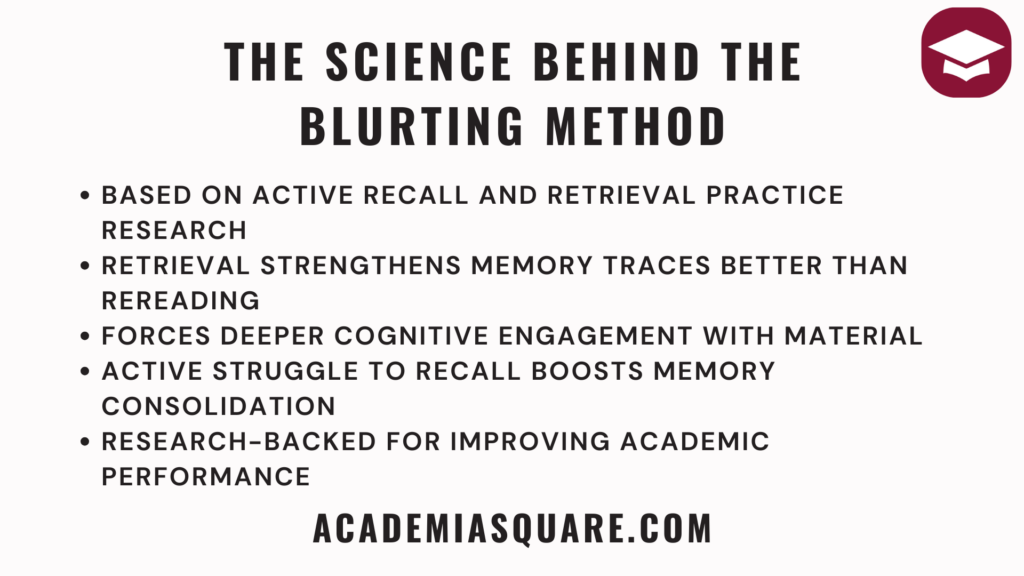
The Blurting Method is rooted in cognitive science, particularly the principles of active recall and retrieval practice. These are two well-researched techniques that have shown to improve learning efficiency and memory retention. Active recall involves actively trying to remember information, rather than passively rereading it, while retrieval practice refers to repeatedly recalling information over time to strengthen memory. Together, these strategies form the backbone of the Blurting Method, making it a powerful tool for students and learners.
How Active Recall Improves Learning
Active recall is based on the idea that retrieving information from memory strengthens neural connections. Research consistently shows that when learners test themselves on material, rather than just reviewing notes or textbooks, their long-term retention improves. The Blurting Method takes advantage of this principle by encouraging learners to recall everything they can about a subject from memory. This process forces the brain to work harder, making the information stick more effectively.
The Role of Spaced Repetition
Another cognitive principle that enhances the Blurting Method is spaced repetition. This method involves reviewing information at increasing intervals over time. Combining blurting with spaced repetition can significantly boost retention because the brain is repeatedly exposed to the material over extended periods. Research shows that spaced repetition helps consolidate information into long-term memory, allowing learners to retain it more effectively than with cramming or one-off study sessions.
Memory Consolidation and the Blurting Method
Memory consolidation is the process by which short-term memories are transformed into long-term memories. The Blurting Method aids this process by challenging learners to recall and reapply knowledge, which accelerates consolidation. As you blurting, your brain continuously revisits the material, reinforcing neural pathways and facilitating stronger memory traces. This results in deeper, more durable learning that can be accessed long after the initial study session.
Key Scientific Benefits of the Blurting Method
- Improved retention: Active recall strengthens long-term memory storage.
- Deeper understanding: Active engagement helps you grasp the material more thoroughly.
- Faster learning: Spaced repetition combined with blurting accelerates memory consolidation.
By engaging the brain in active, repetitive learning, The Blurting Method helps learners retain information more effectively and apply it in real-world situations.
How to Set Up for the Blurting Method
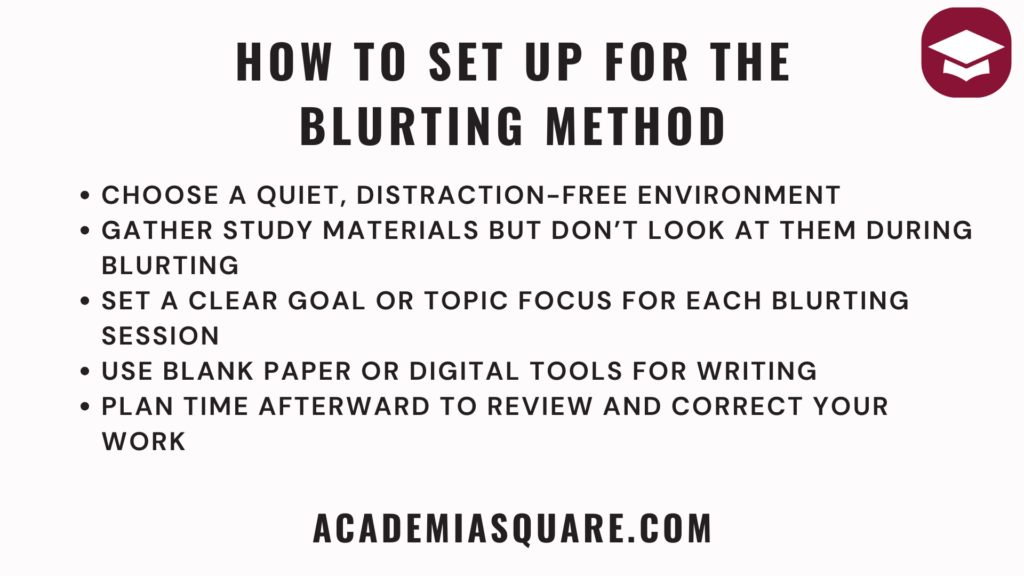
To get the most out of the Blurting Method, it’s essential to set up your study session properly. While the technique is simple, creating the right environment and having the necessary materials can make all the difference in its effectiveness. Below, we’ll discuss how to prepare both mentally and physically for a blurting session, ensuring that you get the most out of this active recall technique.
Preparing Your Study Environment
A calm, distraction-free environment is crucial for any study session, and the Blurting Method is no exception. Set up a quiet space where you can concentrate fully on recalling information. Make sure your desk is clear, and your materials are within reach. Having a clean and organized study space helps to focus the mind and reduce unnecessary distractions.
Gathering Your Materials
For the Blurting Method to work, you’ll need a few basic materials. A notebook or piece of paper is essential for writing down what you remember. Some learners prefer to use a digital device, but research shows that writing by hand activates different cognitive processes and strengthens memory retention. It’s also a good idea to have your notes or textbooks nearby for reference, but only after you’ve completed the blurting session.
Choosing a Study Topic
The next step is selecting the topic you wish to study. The Blurting Method works best for subjects that require memorization, such as history, science, or languages. Start with a specific chapter or subtopic, and make sure it’s a manageable amount of content to recall. Trying to recall too much at once can be overwhelming and counterproductive. Break larger topics into smaller chunks for easier focus.
Setting a Timer for Your Session
Time management is an important element in any study strategy, and the Blurting Method is no different. Setting a timer for your blurting session helps to create a sense of urgency and keeps you focused. A typical blurting session lasts between 15 to 30 minutes, depending on the complexity of the material. After the timer goes off, take a break before moving on to another topic or session. This prevents burnout and allows for better retention in the long run.
Key Preparation Steps for Blurting
- Create a distraction-free space: A clean, quiet area helps focus.
- Prepare materials: Have paper or digital tools ready for writing.
- Break down topics: Focus on smaller chunks of information to recall.
- Set a timer: Keep your study session within a manageable time frame.
Once you’ve prepared your study environment and materials, you’re ready to start blurting! A structured approach sets the foundation for effective recall, allowing you to actively engage with the material and maximize your study time.
Step-by-Step Guide: How to Blurting
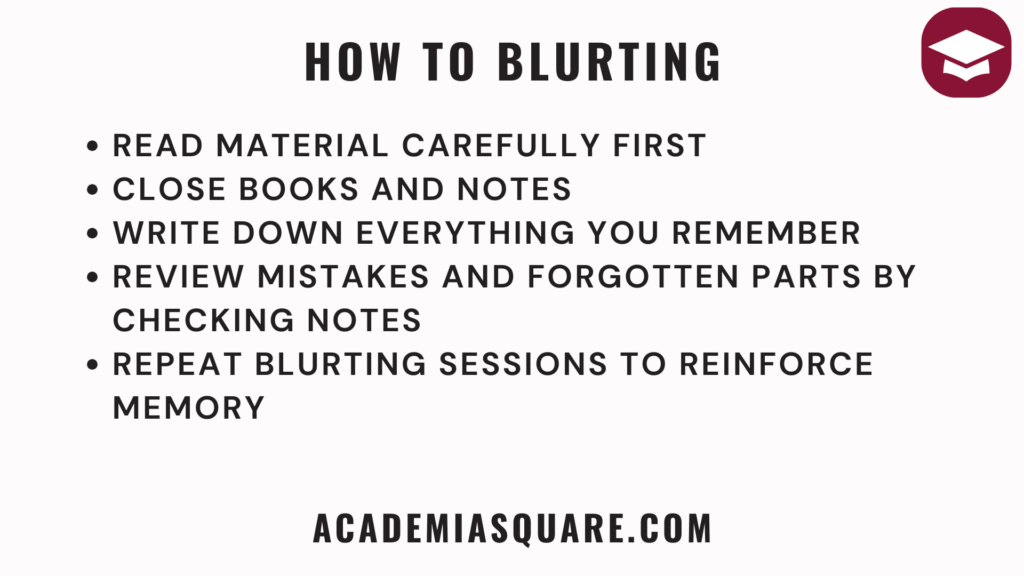
The Blurting Method may sound simple, but its effectiveness comes from following a structured approach. In this chapter, we’ll break down the step-by-step process for implementing blurting in your study routine. Whether you’re studying for exams, preparing for presentations, or mastering a new topic, understanding how to blurting effectively can maximize your learning potential.
Step 1: Choose Your Study Topic
The first step in using the Blurting Method is to choose a topic you want to study. Select a subject or chapter that you’ve already studied or are familiar with. The goal is to recall as much information as possible about the topic, so you want to ensure that there is some prior exposure to the material. It’s best to start with smaller chunks of information, like a subtopic or a single chapter, to avoid feeling overwhelmed.
Step 2: Start Writing What You Know
Once you’ve chosen your topic, the next step is to start blurting—writing down everything you know about the subject. Do not refer to your notes or textbooks at this point. Simply write down all the key facts, concepts, and ideas that come to mind. This process may feel challenging at first, especially for difficult subjects, but that’s the point—your brain will be actively retrieving information, which helps reinforce memory. Don’t worry if you can’t recall everything or if you leave gaps. Just write what you know and move quickly.
Step 3: Review and Identify Gaps
After completing the blurting step, the next important phase is to review what you’ve written. Now, go back to your notes or textbook to compare what you’ve recalled with the material you studied. This helps you identify any gaps in your knowledge. Mark the areas where you struggled to remember the information and focus on these weaknesses in your next round of study. This review process ensures that you’re not just memorizing, but actively improving your understanding.
Step 4: Revisit and Repeat
The final step in the Blurting Method is repetition. To maximize the benefits of blurting, you should repeat the process over several study sessions. Start with a new round of blurting on the same topic after a short break. Each time, you will be able to recall more information, and the gaps in your knowledge will gradually shrink. This method aligns with the concept of spaced repetition, where repeated exposure to the material over time strengthens long-term retention.
Key Steps for Effective Blurting
- Select a manageable topic: Focus on a small chunk of information you want to master.
- Write everything you know: Don’t refer to your notes—challenge your memory.
- Review and identify gaps: Compare your blurts with your notes and spot weaknesses.
- Repeat the process: Use spaced repetition to reinforce and improve recall over time.
Following these steps consistently will help you retain information more efficiently, making the Blurting Method a highly effective study strategy. With regular practice, you’ll notice improvements in both memory retention and understanding of complex subjects.
Common Mistakes to Avoid with the Blurting Method
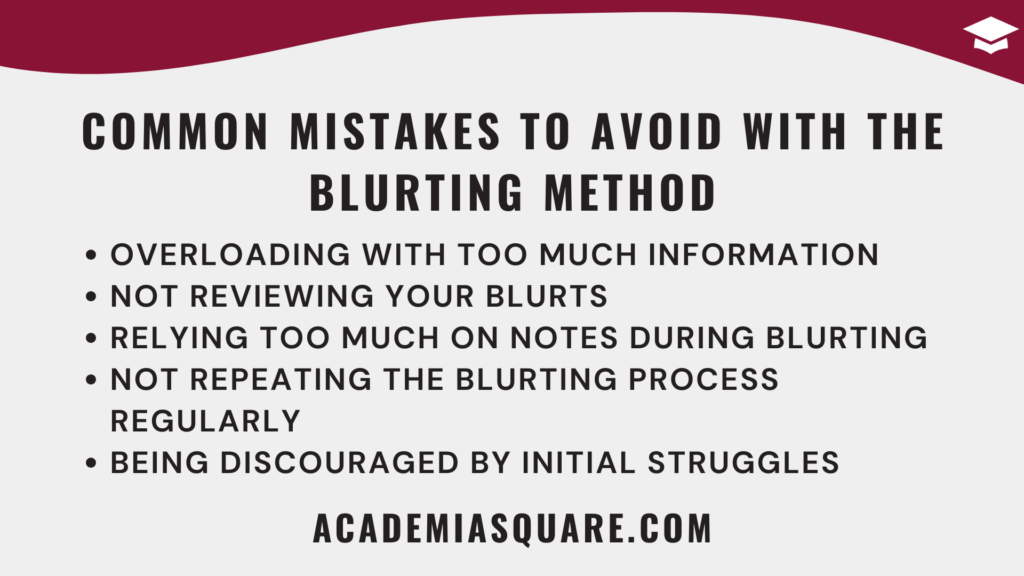
While the Blurting Method is an effective technique, it’s easy to make mistakes that can hinder its effectiveness. Understanding these common pitfalls can help you avoid them and ensure that you’re getting the most out of your study sessions. In this chapter, we’ll explore some of the key mistakes to watch out for and provide tips on how to correct them.
1. Overloading with Too Much Information
A common mistake when using the Blurting Method is attempting to recall too much information at once. While it might seem productive to try and recall entire chapters or multiple topics, this approach can be overwhelming and reduce the quality of your recall. Instead, focus on smaller, manageable chunks of information. Breaking down larger topics into smaller subtopics allows for more focused blurting and makes it easier to retain key details.
2. Not Reviewing Your Blurts
Another mistake is failing to properly review the information you’ve written down. Simply blurting without taking the time to compare your recall to your notes or textbooks misses a key aspect of the technique. Reviewing your blurts and identifying knowledge gaps is essential for improvement. The power of the Blurting Method lies not just in recalling information but in actively pinpointing areas that need more attention and revisiting them in future sessions.
3. Relying Too Much on Notes During Blurting
Some learners make the mistake of relying on their notes or textbooks during the blurting process. While it’s important to have these materials available after your blurting session, referring to them during the recall process undermines the active recall aspect. The key to successful blurting is to challenge your memory without external help. Only after you’ve finished writing should you look back at your materials to see what you missed or got wrong.
4. Not Repeating the Blurting Process Regularly
Consistency is crucial when using the Blurting Method, and many learners fail to make blurting a regular habit. To truly benefit from this technique, it’s important to repeat the process over multiple study sessions. Spacing out your blurting sessions, known as spaced repetition, helps to reinforce long-term memory and solidify your understanding. Skipping this repetition reduces the long-term benefits of the method.
5. Being Discouraged by Initial Struggles
It’s important to understand that blurting can be difficult, especially at first. If you find yourself struggling to recall information, don’t be discouraged. This is a natural part of the learning process and an indicator that your brain is working hard to create and strengthen connections. Embrace the struggle as part of your learning journey, and remember that with practice, your recall will improve.
Key Mistakes to Avoid
- Avoid overloading: Break down large topics into manageable chunks.
- Always review: Compare your blurts with notes to identify gaps.
- Don’t rely on notes: Challenge your memory before reviewing materials.
- Repeat regularly: Use spaced repetition to reinforce memory.
- Don’t get discouraged: Struggles are part of the learning process.
Enhancing Your Learning with the Blurting Method
Although the Blurting Method is a powerful study technique on its own, combining it with other learning strategies can enhance its effectiveness even further. By integrating complementary methods, you can create a well-rounded approach to studying that targets multiple cognitive processes. In this chapter, we’ll explore how to combine the Blurting Method with other proven strategies for optimal learning.
Combining Blurting with Spaced Repetition
Spaced repetition is a highly effective technique for improving long-term retention. By combining it with the Blurting Method, you can reinforce the material you’ve already recalled and identify areas that need more focus. After each blurting session, revisit your notes or flashcards after a set interval to test your recall. This creates a cycle of spaced learning that strengthens memory consolidation and minimizes forgetting.
Integrating Mind Mapping with Blurting
Mind mapping is a visual learning tool that helps to organize information in a way that’s easy to understand. By integrating mind maps with the Blurting Method, you can visually structure the information you’re recalling, making it easier to see connections between concepts. After completing a blurting session, create a mind map that links the main ideas. This process helps reinforce your understanding and makes it easier to recall related concepts.
Pairing Blurting with Active Learning
Active learning involves engaging with the material in an interactive way rather than passively reviewing it. When using the Blurting Method, pair it with active learning strategies such as teaching the material to someone else, solving problems, or discussing key concepts with peers. These activities help reinforce the information you’ve blurred and provide additional opportunities for recall and application. The more actively you engage with the material, the better your retention will be.
Using the Feynman Technique alongside Blurting
The Feynman Technique is a method of learning that involves explaining concepts in simple terms as though you were teaching someone else. When combined with the Blurting Method, it provides an additional layer of active engagement. After blurting out everything you know about a topic, explain it to someone else (or even yourself) in the simplest language possible. This helps clarify your understanding and exposes any gaps in your knowledge that you can then revisit in future blurting sessions.
Key Strategies for Enhancing Blurting
- Spaced repetition: Use intervals to reinforce your blurts and strengthen memory.
- Mind mapping: Organize concepts visually to improve understanding and recall.
- Active learning: Engage with the material interactively for deeper retention.
- Feynman Technique: Teach concepts in simple terms to reinforce understanding.
By incorporating these learning techniques with the Blurting Method, you create a multi-faceted approach to studying that targets different aspects of memory and comprehension. This combination not only boosts your ability to recall information but also strengthens your overall learning process, allowing you to retain and apply knowledge more effectively.
Tracking Progress and Measuring Success with the Blurting Method
To truly benefit from the Blurting Method, it’s essential to track your progress and measure how effective the technique is for your learning. Monitoring your development ensures that you’re improving over time and allows you to make necessary adjustments. In this chapter, we’ll explore different ways to assess your success with blurting and how to refine your approach for even better results.
Keeping Track of Your Blurting Sessions
One way to measure your success with the Blurting Method is by keeping a detailed log of each study session. Record the topic, the time spent blurting, and any key insights or challenges you encountered. This log allows you to review your sessions, identify patterns, and see how your recall improves over time. It’s also helpful for pinpointing areas that need more focus, so you can adjust your study approach accordingly.
Assessing Recall Accuracy
As you complete more blurting sessions, it’s crucial to assess how accurate your recall is. After writing down everything you know, compare it with your notes or textbooks to evaluate how much you missed or got wrong. Tracking the number of correct facts versus incorrect ones helps you identify which topics or details require additional review. Gradually, as your accuracy improves, you’ll notice that you are recalling more relevant information and fewer gaps appear in your blurting sessions.
Using Timed Assessments to Measure Improvement
Another effective method for tracking your progress is by using timed assessments. Set a timer for each blurting session to measure how quickly you can recall information. Over time, you’ll likely notice that you’re able to recall the same amount of information in less time, a clear indicator of improved memory retention. Using this approach also helps to simulate exam conditions, which can further enhance your preparedness for real-world testing environments.
Evaluating the Retention of Learned Information
Long-term retention is the ultimate goal of the Blurting Method. To assess how well you’ve retained information, test yourself on the material after a period of time—this could be days or even weeks later. Revisit the topics you’ve blurred and see how much you can recall without reviewing your notes. If you find yourself forgetting key information, it’s an indication that the material needs to be revisited and re-processed using the blurting technique.
Key Methods for Tracking Progress
- Maintain a log: Keep track of your study sessions to identify patterns and insights.
- Assess accuracy: Compare your blurts with notes to measure recall success.
- Use timed assessments: Track how quickly you can recall information over time.
- Test retention: Revisit material after time to evaluate long-term retention.
Regular self-assessment helps you fine-tune your approach and stay motivated as you witness your growth in both recall accuracy and retention over time.
Advanced Techniques for Mastering the Blurting Method
While the Blurting Method is already a highly effective strategy for learning, there are ways to refine and elevate your approach. By applying advanced techniques, you can significantly improve your ability to recall and retain information. In this chapter, we’ll explore several strategies that can help you take your blurting practice to the next level and make your study sessions even more powerful.
1. Interleaving: Mixing Up Topics
One advanced technique you can use alongside the Blurting Method is interleaving. This involves switching between different topics or subtopics during your study sessions, rather than focusing on just one topic at a time. Research suggests that interleaving enhances learning by forcing the brain to make connections between different concepts, improving the ability to recall information when needed. To implement interleaving, alternate between subjects or chapters every few blurting sessions, which will help improve overall retention and application of knowledge.
2. Teaching Others: The Feynman Effect
Another effective advanced technique is teaching what you’ve learned to someone else, often referred to as the Feynman Technique. After completing a blurting session, take a few moments to explain the material as if you were teaching it to a peer. This process forces you to articulate your understanding clearly, which solidifies your grasp of the material. Teaching others not only helps clarify any gaps in your knowledge but also reinforces the key points you’ve learned through blurting.
3. Self-Testing: Creating Practice Questions
Self-testing is another powerful strategy that can enhance the Blurting Method. After each blurting session, write down practice questions based on the material you’ve recalled. These questions can be true/false, multiple choice, or open-ended, depending on the subject matter. The process of answering your own questions helps strengthen memory retrieval and promotes active recall. Revisit these questions in future study sessions to measure your progress and further consolidate the material.
4. Visualization: Enhancing Recall Through Imagery
Visual aids can significantly improve memory recall. By incorporating visualization into your Blurting Method practice, you create mental images associated with the material you’re studying. For instance, when blurting about a historical event, you could visualize the scene or draw diagrams that represent key concepts. These images serve as memory cues, which make it easier to retrieve information later on. Visualization is particularly effective for abstract concepts or complex ideas that are difficult to remember through text alone.
Key Advanced Techniques for Blurting
- Interleaving: Alternate between topics to improve connections and retention.
- Teaching others: Use the Feynman Technique to explain concepts and reinforce learning.
- Self-testing: Create practice questions to promote active recall and measure progress.
- Visualization: Use imagery to enhance memory recall and create strong associations.
These strategies help solidify your learning, making it easier to recall information and apply it in different contexts. The more you refine your approach, the more powerful the Blurting Method becomes in enhancing your overall study effectiveness.
FAQs – How to Use the Blurting Method for Studying
What is the blurting method for studying?
The blurting method is a study technique where you write down everything you remember about a topic without looking at your notes. It promotes active recall, which is scientifically proven to enhance long-term memory retention (Karpicke & Roediger, 2008).
Why is active recall important in learning?
Active recall strengthens memory by forcing your brain to retrieve information, which enhances neural connections. Research from Purdue University shows it significantly outperforms passive review techniques in improving exam performance.
How do you do the blurting method effectively?
Start by studying a topic, then close your notes and write down everything you remember. Afterward, review your notes to check what you missed. Repeat this cycle to reinforce recall and retention.
Does the blurting method help with exam anxiety?
Yes, blurting builds confidence by reinforcing memory, reducing anxiety. Studies show that students who feel prepared through retrieval practice experience lower cortisol levels during exams (Putwain & Daly, 2014).
How often should I use the blurting technique?
Use the blurting method at least twice a week per subject. Combining it with spaced repetition enhances long-term retention and aligns with cognitive science principles for optimal learning.
Is the blurting method suitable for all subjects?
Yes, blurting works well across subjects, especially for content-heavy areas like biology, history, or law. It’s less effective for subjects requiring problem-solving unless combined with practice questions.
What materials do I need for blurting?
You only need paper, a pen, and your study notes. Optionally, use highlighters to mark missed or weak areas during review to target them in your next study session.
How long should a blurting session be?
Blurting sessions should last between 20 to 40 minutes. Keep sessions focused and allow time to review your answers and re-study missed content immediately afterward for maximum benefit.
What are the cognitive benefits of blurting?
Blurting improves metacognition, or your awareness of what you do and don’t know. It also increases retrieval strength and memory consolidation, as supported by neuroscience research on active learning strategies.
Can blurting replace flashcards?
Blurting can complement or even replace flashcards. It covers broader content recall, while flashcards are better for targeted fact testing. Use both for a well-rounded study routine.
Is there any scientific support for the blurting method?
Yes, blurting aligns with retrieval practice, which is backed by cognitive psychology research. Karpicke & Blunt (2011) found that students using retrieval-based techniques retained 50% more than those who only reread material.
Can I use the blurting method with digital tools?
Yes, digital tools like Notion, Google Docs, or even voice memos can support blurting. However, writing by hand may increase retention, as studies suggest handwriting enhances memory and comprehension (Mueller & Oppenheimer, 2014).
Sources and Recommended Reading on the Blurting Method
- Yang, C., Potts, R., & Shanks, D.R. (2022). “The Testing Effect with Free Recall: Organization, Attention, and Order.” Journal of Memory and Language, 125, 104328.
- Stern, P., & Halamish, V. (2023). “Free-Recall Retrieval Practice Tasks for Students with ADHD: Whole-Text versus Section Recall.” Frontiers in Psychology, 14, 1301726.
- Karpicke, J.D., & Roediger, H.L. (2013). “Retrieval Practice Enhances Learning: The Role of Free Recall.” Psychological Science, 24(10), 1819–1827.
- Pyc, M.A., & Rawson, K.A. (2019). “Why Is Free Recall Practice More Effective Than Recognition Practice? Insights from Retrieval Effort and Memory Strengthening.” Journal of Memory and Language, 104, 104047.
- Endres, T., et al. (2020). “It Matters How to Recall – Task Differences in Retrieval Practice.” Educational Psychology Review, 32, 1–20.
- Zaromb, F.M., & Roediger, H.L. (2010). “The Testing Effect in Free Recall Is Associated with Enhanced Organizational Processes.” Memory & Cognition, 38(8), 995–1008.
- de Lima, M., & Jaeger, A. (2021). “A Systematic Review of the Testing Effect in Learning.” Paideia, 31, e3137.
- Carpenter, S.K., & Pashler, H. (2024). “Retrieval Practice: A Tool for Teaching the Control-of-Variables Strategy.” Journal of Educational Psychology, 116(2), 345–360.
- Pastötter, B., & Bäuml, K.-H.T. (2017). “Free Recall Test Experience Potentiates Strategy-Driven Effects of Value on Memory.” Psychonomic Bulletin & Review, 24(5), 1564–1570.
- Karpicke, J.D. (2009). “Organizational Processes Contribute to the Testing Effect in Free Recall.” Washington University Open Scholarship.


